Untold Stories (66 page)
Authors: Alan Bennett

Excepted from these irreverences is the Rembrandt etching
Christ
Returning from the Temple with His Parents
, who don't look like the Holy
Family at all but peasants out for a walk complete with dog. He's one of Rembrandt's frisky and utterly non-symbolic dogs. Maybe that's why he's frisky, because he knows he doesn't have to represent fidelity or trust or anything at all from Hall's
Dictionary of Subjects and Symbols
. He's just happy to be All Dog.
A
TKINSON
G
RIMSHAW
,
Park Row, Leeds, by Moonlight
, 1882
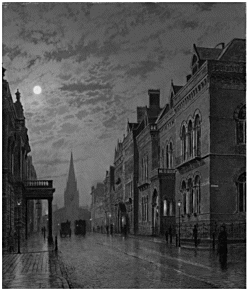
Anyone who knows Leeds will find this painting,
Park Row
by Atkinson Grimshaw, almost a documentary record (the church apart) of how the street looked as late as 1960, which was when the city fell to greed and mediocrity.
Some silly people on the right nowadays wish the sixties hadn't happened because that was when people discovered sex and pot-smoking. I wish the sixties hadn't happened because that was when avarice and stupidity got to the wheel of the bulldozer. They called it enterprise and still do, but the real enterprise would have been if someone in 1960 had had the clout and the imagination to say, âLet us leave this city much as it is, convert it perhaps, replumb it, but nothing else.'
If they had, Leeds today would have been one of the architectural showplaces of the kingdom, a Victorian Genoa or Florence, on the
buildings of which many of its banks and commercial properties (like the one in the right foreground) were modelled. Instead it's now like anywhere else.
A
NTONIO
C
ANOVA
,
The Hope of Venus
, c.1818â20
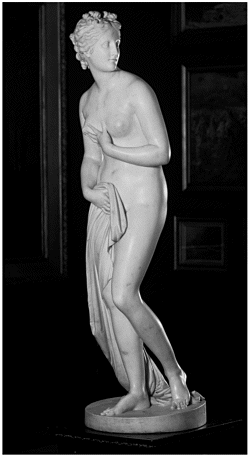
I've included this sculpture by Canova simply as a reminder. In all the fuss there was earlier this year about retaining his
Three Graces
in this country I saw no mention of this or other sculptures by him that were already in public galleries here and which were comparatively unregarded. Now it's true that Leeds has only one lady not three, but whereas the
Three Graces
are in a bit of a huddle here you can at least see Venus in the round.
P
ATRICK
W
ILLIAM
A
DAM
, Interior, Rutland Lodge, Potternewton, 1920
Interior,
Rutland
Lodge: vista through open doors
, 1920
G
EORGE
C
LAUSEN
,
A Girl in Black
, 1913
The name Sam Wilson suggests some bluff mill owner standing foursquare on the hearthrug with his thumbs in his waistcoat, holding forth about the shortcomings of the workers and generally laying down the law. In fact Sam Wilson seems to have been a discerning, if rather conservative collector and his house at Potternewton must have been crowded out with the pictures he left to the Art Gallery in 1915.
I've chosen three, two which I remember from childhood and the third, by George Clausen, because it appeals to me now. The two pictures of his house by Patrick William Adam aren't remarkable as paintings but I used to look at them and think that this was the kind of house I would one day like to live in â a place of hushed, handsome rooms, and rooms that gave onto other rooms and rooms beyond them, all bathed in a subdued aqueous light and the setting for a life of great elegance. Nothing could be further removed from our homely (but entirely comfortable) kitchenâliving room in Otley Road.
This vision of gracious living remains a vision (and now an unwanted one) though the sense of long views through a house still gives me pleasure when I walk through the upper floors at Temple Newsam.
J
OHN
S
ELL
C
OTMAN
,
On the River Yare
, 1807â8
Refectory of
Walsingham
Priory
, 1807â8
A Ploughed Field, c
.1808
I can see that in aesthetic terms my liking for Cotman's watercolours is related to my fondness for the Camden Town school of painting. With both the colour range is quite narrow, the closeness of the tones imparting a kind of glow to the paper or canvas and which, more than subject, line or setting, draws me to it.
I can say nothing about the composition of these wonderful works though even I can see that the man's red cap at the centre of
On the River
Yare
is an inspired touch. Part of the pleasure, I'm sure, is nostalgic, a longing for England as it once was â or perhaps never quite was, as Cotman creates as well as records a world.
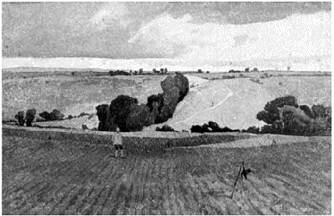
On a more prosaic note, the crow that hangs from the stick in
A Ploughed
Field
is a feature of the countryside that has always puzzled me. Displaying the carcasses of crows (and also moles) is (or used to be) a favourite device of gamekeepers though quite to what end I'm not sure. Perhaps the farmer or gamekeeper is simply advertising his skill as a killer of crows and catcher of moles. But it seems to me that the unfortunate creatures were also strung up as an Awful Warning. The unshot crows and unsnared moles were meant to take note of the carcasses of their unlucky fellows and take the lesson to heart: in future they must Mend Their Ways (i.e. not behave like crows or moles). It seems flippant when spelled out but there is some unthought-out notion like this at the back of such displays, deriving, I suppose, from the assumption that potential human wrongdoers would be deterred by the bodies of thieves left hanging on gibbets.
L
UCIEN
P
ISSARRO
,
Wells Farm Railway Bridge,
Acton, 1907
A
NDRé
D
ERAIN
,
Barges on the Thames
, about 1906
I remember thinking as a boy, and without knowing anything about
Les
Fauves
, that this was quite a fierce picture and being rather pleased with myself that I liked it. The colours were so bold and uncompromising and,
literal-minded as I was then, I knew that they were untrue and that the much muddier Camden Town version of London on view elsewhere in the Gallery was closer to the real thing.
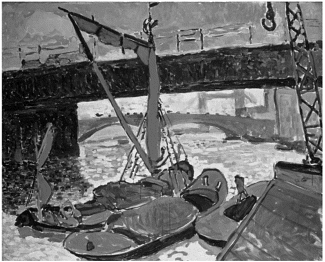
I like the unashamed way the blue crane turns red when it's crossing the line of the blue bridge and the cheeky toy train in what, I suppose, is a version of Southern Railways green, puffing across to Broad Street. A nice exhibition (I'm sure there's been one) would be the English scene through French eyes. It would include Derain, Monet, Pissarro (of which Leeds has a good example) and Agasse, two of whose slightly sinister paintings were in a recent exhibition at the National Gallery.
Derain had a sad end. He behaved rather disreputably during the Second War and was one of several artists, including Vlaminck, who went on a sponsored tour of Germany and at the Liberation was denounced by Picasso. Tall and burly, he was a boxer in his youth; he died in 1954 after being run over. When asked if there was anything he wanted his last words were: âA bicycle and a piece of sky.'
W
ALTER
R
ICHARD
S
ICKERT
,
The New Bedford
, 1916â17
M
ALCOLM
D
RUMMOND
,
The Coconut Shy
, c.1920
H
AROLD
G
ILMAN
, Mrs Mounter, 1916â17
In
Sickert's
House
,
c
.1907
Portrait of Spencer Frederick Gore
, 1906â7
J
EAN
E
DOUARD
V
UILLARD
,
Mlle
Nathanson
in the
Artist's
Studio
,
c
.1912
S
PENCER
F
REDERICK
G
ORE
,
In Berkshire
, 1912
Interior with Nude
,
c
.1907
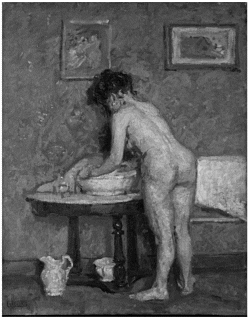
It's said that when people come to London they settle near the station where they first arrive. Thus north of Euston (the station for Liverpool) one finds the Irish; Southall (near to Heathrow) is the centre of the Asian community; and even the Australians in Earls Court fit into the theory because once upon a time British Airways had its passenger terminal there.
I conform to the theory myself: King's Cross was the station I arrived at and for thirty years I've lived not far away in Camden Town.
Though the dreadful Camden Lock and its attendant touristification has driven out anything resembling normal life from large areas there are still parts of Camden Town that haven't changed since Sickert, Gilman and Gore were painting here at the turn of the last century.
Sickert lived all over the place, and briefly in the street where I live now, but his blue plaque is in Mornington Crescent. Spencer Gore was nearby, though his lodgings were demolished in the thirties to make way for the
Black Cat cigarette factory, itself an Art Deco monument but stripped in the 1960s of everything that made it distinctive.
When I first moved here part of the New Bedford music hall was still standing, and the site is vacant even today. I like Sickert's painting of it though the picture of his I would have chosen was of the front of St Mark's in Venice. This used to hang in the Gallery in the 1950s but it was only on loan and has now been reclaimed.